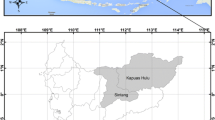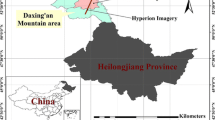Abstract
Hyper spectral remote sensing is widely used to identify ground objects as a result of the advantages of ground radiation intensity characteristics and spectral position characteristics, in which inversion of vegetation components is the difficult point and hotspot. In this study, Huma county of Heilongjiang Province was selected as the study area, the canopy spectra of four types of typical vegetation were measured in situ firstly, including mongolian oak, cotton grass, lespedeza and white birch. Then, on the basis of analyzing the canopy spectral characteristics and their parameterization, the spectral differences of different vegetations were located, and the parameterization method of characteristics identification was determined. Finally, Hyperion data were used to calculate the canopy albedos based on the bidirectional reflectance model of vegetation canopies, and to map the vegetation components in the study area by use of linear spectral mixture model. The results showed that inversion of vegetation components in high vegetation-covered area was accurate using the canopy albedos and liner spectral mixture model, and was identical with the field sampling, which validated the feasibility of canopy albedos and liner spectral mixture model for the inversion of vegetation components.





Similar content being viewed by others
References
Adams, J. B., Smith, M. O., & Johnson, P. E. (1986). Spectral mixture modeling—A new analysis of rock and soil types at the Viking Lander-1 site. Journal of Geophysical Research, Solid Earth and Planets, 91, 8098–8112.
Bell, J. F., Farrand, W. H., Johnson, J. R., et al. (2002). Low abundance materials at the Mars Pathfinder landing site: An investigation using spectral mixture analysis and related techniques. Icarus, 158, 56–71.
Elmore, A. J., Mustard, J. F., Manning, S. J., et al. (2000). Quantifying vegetation change in semiarid environments: Precision and accuracy of spectral mixture analysis and the normalized difference vegetation index. Remote Sensing of Environment, 73, 87–102.
Fauvel, M., Chanussot, J., & Benediktsson, J. A. (2012). A spatial–spectral kernel-based approach for the classification of remote-sensing images. Pattern Recognition, 45, 381–392.
Funk, C. C., & Brown, M. E. (2006). Intra-seasonal NDVI change projections in semi-arid Africa. Remote Sensing of Environment, 01, 249–256.
Haboudane, D., Bonn, F., Royer, A., et al. (2002). Land degradation and erosion risk mapping by fusion of spectrally-based information and digital geomorphometric attributes. International Journal of Remote Sensing, 23, 3795–3820.
Johnson, P. E., Smith, M. O., Taylor-George, S., et al. (1983). A semiempirical method for analysis of the reflectance spectra of binary mineral mixtures. Journal of Geophysical Research, 88, 3557–3561.
Keshava, N., & Mustard, J. F. (2002). Spectral unmixing. IEEE Signal Processing, 9, 44–57.
Myneni, R. B., Keeling, C. D., Tucker, C. J., et al. (1997). Increased plant growth in the northern high latitudes from 1981 to 1991. Nature, 386, 698–702.
Phinn, S., Stanford, M., Scarth, P., et al. (2002). Monitoring the composition of urban environments based on the vegetation-impervious surface-soil (VIS) model by subpixel analysis techniques. International Journal of Remote Sensing, 23, 4131–4153.
Pinty, B., Verstraete, M. M., & Dickinson, R. E. (1990). A physical model of the bidirectional reflectance of vegetation canopies 2. Inversion and validation. Journal of Geophysical Research, 95(11767–11), 775.
Riano, D., Chuvieco, E., Ustin, S., et al. (2002). Assessment of vegetation regeneration after fire through multitemporal analysis of AVIRIS images in the Santa Monica Mountains. Remote Sensing of Environment, 79, 60–71.
Roberts, D. A., Dennison, P. E., Gardner, M., et al. (2003). Evaluation of the potential of Hyperion for fire danger assessment by comparison to the airborne visible infrared imaging spectrometer. IEEE Transactions on Geoscience and Remote Sensing, 41(6), 1297–1310.
Somers, B., Asner, G. P., Tits, L., & Coppin, P. (2011). End-member variability in spectral mixture analysis: A review. Remote Sensing of Environment, 115(7), 1603–1616.
Verstraete, M. M., Pinty, B., & Dickinson, R. E. (1990). A physical model of the bidirectional reflectance of vegetation canopies, 1: Theory. Geophysical Research, 95, 11755–11765.
Wang, Q. J., Lin, Q. Z., Li, M. X., et al. (2009). Comparison of two spectral mixture analysis models. Spectroscopy and Spectral Analysis, 29(10), 2602–2605.
Woessner, P., & Hapke, B. (1987). Polarization of light scattered by clover. Remote Sensing of Environment, 21, 243–261.
Yamagata, Y., Nakamura, F., & Kaneko, M. (2001). Development of WTI and turbidity estimation model using SMA—Application to Kushiro Mire, eastern Hokkaido, Japan. Remote Sensing of Environment, 77, 1–9.
Zhang, H., Yao, Z. Y., Quan, H., et al. (1999). New idea on the botano-geochemical exploration in Daxinganling forest covered area. Journal of Precious Metallic Geology, 8(1), 38–40.
Acknowledgements
This study was supported by the National Natural Science Foundation of China (No. 40971187), the funded by Open Research Fund Program of Key Laboratory of Digital Mapping and Land Information Application Engineering, National Administration of Surveying, Mapping and Geoinformation (No. GCWD201402). In addition, we wish to express our gratitude to Chiba Institutes of Technology of Japan for their instruments and the experiment site.
Author information
Authors and Affiliations
Corresponding author
About this article
Cite this article
Wang, M., Niu, X., Yang, Q. et al. Inversion of Vegetation Components Based on the Spectral Mixture Analysis Using Hyperion Data. J Indian Soc Remote Sens 46, 1–8 (2018). https://doi.org/10.1007/s12524-017-0661-2
Received:
Accepted:
Published:
Issue Date:
DOI: https://doi.org/10.1007/s12524-017-0661-2




